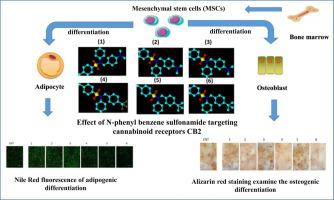Process Biochemistry ( IF 3.7 ) Pub Date : 2023-08-18 , DOI: 10.1016/j.procbio.2023.08.009 Siddique Akber Ansari , Hatoon Youssef Alkeraim , Amer Mahmood , Musaad Alfayez , Sarfaraz Ahmed , Irfan Aamer Ansari , Abdulrahman A. Almehizia , Lamees S. Al-Rasheed , Hamad M. Alkahtani

|
Cannabinoids receptor type 2 (CNR2) signaling using selective receptor compounds encourages the expression of osteogenic genes and enhances mineralization. The effect of six newly synthesized Cannabinoid receptors type 2 (CB2) selective compounds over the viability of human bone marrow mesenchymal stem cells (h-BMMSCs) and their osteogenic and adipogenic potential study was carried out. Human mesenchymal stem cells (MSCs) were treated with 0.5 μM of compounds 1–6 to induce lineage differentiation (adipogenic, osteogenic). The cells were analyzed using differentiation assays, lipid droplets and mineralized matrix was stained with “Niel red and Alizarin Red, further performed reverse transcription-polymerase chain reaction (RT-PCR) for lineage-specific markers expression.” Treatment with synthesized compounds N-(4-(dimethyl amino) benzyl)− 4-methyl-N-phenylbenzenesulfonamide (1), N-(4-(dimethyl amino) benzyl)-N-phenyl benzamide (3) and N-(4-tert-butylbenzyl)− 4-methyl-N-phenylbenzenesulfonamide (5), increased both lipid droplets formation and Alkaline Phosphatase (ALP) activity. Treatment of N-(4-(dimethylamino) benzyl)-N-phenylbenzene sulfonamide (2), and 4-methyl-N-phenyl-N-(4-(trifluoromethyl) benzyl) benzene sulfonamide (4) was found to enhance the adipogenic differentiation of (h-BMSCs) and inhibit osteogenic differentiation. A Reduction in adipocyte differentiation upon exposure to N-(4-tert-butylbenzyl)-N-phenylbenzene sulfonamide (6) was noted. Conversely, enhanced mineral deposition was accompanied by increased alkaline phosphatase (ALP) activity in osteogenic differentiation. Taken together, these newly synthesized selective compounds work in favor of adipocyte formation except for 6 which reduces lipid droplets accumulation and enhanced calcium deposition. “In conclusion, compounds 1, 3, 5 and 6 demonstrated a positive effect over osteoblast formation compared to control.” As per molecular docking study, compounds 1, 2 and 3 are the most active derivative will serve as anti-osteoporosis drug discovery.
中文翻译:

靶向CNR2的N-苯基苯磺酰胺对人骨髓间充质干细胞群和成骨细胞/脂肪细胞分化的影响
使用选择性受体化合物的 2 型大麻素受体 (CNR2) 信号传导可促进成骨基因的表达并增强矿化。六种新合成的 2 型大麻素受体 (CB 2) 选择性化合物对人骨髓间充质干细胞 (h-BMMSC) 的活力及其成骨和脂肪形成潜力进行了研究。用 0.5 μM 化合物 1-6 处理人间充质干细胞 (MSC),以诱导谱系分化(成脂、成骨)。使用分化分析对细胞进行分析,脂滴和矿化基质用“尼尔红和茜素红染色,进一步进行逆转录聚合酶链反应(RT-PCR)以检测谱系特异性标记物的表达。” 用合成化合物处理 N-(4-(二甲基氨基)苯甲基)− 4-甲基-N-苯基苯磺酰胺 ( 1 )、N-(4-(二甲基氨基)苯甲基)-N-苯基苯甲酰胺 ( 3)和 N-( 4-叔丁基苄基)− 4-甲基-N-苯基苯磺酰胺 (5),增加脂滴形成和碱性磷酸酶(ALP)活性。发现处理 N-(4-(二甲氨基)苄基)-N-苯基苯磺酰胺 ( 2)和 4-甲基-N-苯基-N-(4-(三氟甲基)苄基)苯磺酰胺 ( 4)可以增强(h-BMSC) 的成脂分化并抑制成骨分化。注意到暴露于 N-(4-叔丁基苄基)-N-苯基苯磺酰胺 ( 6)后脂肪细胞分化减少。相反,矿物质沉积的增强伴随着成骨分化中碱性磷酸酶(ALP)活性的增加。总的来说,这些新合成的选择性化合物有利于脂肪细胞的形成,除了6 种以外减少脂滴积累并增强钙沉积。“总之,与对照相比,化合物1、3、5和6对成骨细胞形成具有积极作用。” 根据分子对接研究,化合物1、2和3是最活跃的衍生物,将作为抗骨质疏松药物的发现。






























 京公网安备 11010802027423号
京公网安备 11010802027423号